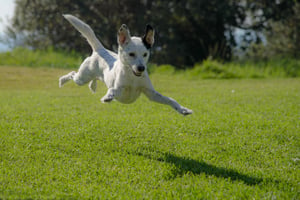Crate training an 8 week old puppy is an important step in establishing a strong bond with your pup...
Crate Training Your 3 Month Old Puppy: A Comprehensive Guide
Crate training your 3 month old puppy is a great way to help them learn the basics of house training and to keep them safe and secure when you're not around. This comprehensive guide will provide you with all the information you need to get started, including the benefits of crate training, the supplies you'll need, and the step-by-step instructions for teaching your pup to love their crate.
What are the Benefits of Crate Training a 3 Month Old Puppy?
Crate training your 3 month old puppy has a number of benefits, including:
- House training: A crate can help your puppy learn the basics of house training, as puppies naturally will not soil their sleeping area.
- Safety: A crate can also provide a safe place for your puppy when you’re not around, keeping them from getting into mischief or getting hurt.
- Bonding: Crate training is also a great way to bond with your new pup, as it gives you an opportunity to interact with them and teach them how to behave.
Crate training your 3 month old puppy can be an incredibly rewarding experience, and is an important part of puppy care and development.
What Supplies Do I Need for Crate Training?
Before you begin crate training your 3 month old puppy, there are a few supplies you’ll need to make sure they’re comfortable and secure in their new space. You’ll need:
- A crate: You’ll need to get a crate that’s the right size for your puppy. It should be roomy enough for them to stand up and move around, but not so big that they can use one end as a bathroom.
- A comfortable bed: Place a comfortable bed in the crate for your puppy to lay on. This will make the crate a more inviting and comfortable space for them.
- Toys: To keep your puppy entertained and occupied while in their crate, you’ll want to provide them with some toys to play with. Consider getting some chew toys or interactive toys to keep them occupied.
Once you’ve gathered the necessary supplies, you’re ready to start crate training your 3 month old puppy.
Step-by-Step Guide to Crate Training a 3 Month Old Puppy
Crate training your 3 month old puppy is a simple process, but it does require patience and consistency. Here are the steps you’ll need to follow to get started:
- Introduce the crate: The first step is to introduce your puppy to the crate. Place the crate in a room they’re familiar with, like the living room or kitchen, and leave the door open. Place some of their favorite toys inside, and let them explore it at their own pace.
- Feeding time: Once your puppy is comfortable with the crate, start feeding them inside it. This will help them associate the crate with positive experiences, and make them more likely to enter it voluntarily.
- Close the door: Once your puppy is comfortable eating inside the crate, start closing the door for short periods of time while they’re eating. Start with just a few minutes, and gradually increase the amount of time you leave them in the crate.
- Stay nearby: When you first start closing the door, stay nearby so your puppy knows you’re still there. This will help them feel more comfortable and reassured.
- Reward good behavior: When your puppy is in the crate, be sure to reward them with treats and praise when they are calm and quiet. This will help reinforce good behavior and make them more likely to return to the crate.
With patience and consistency, you can crate train your 3 month old puppy in just a few weeks. Just remember to take it slow and be sure to reward your pup for good behavior.
Troubleshooting Common Crate Training Issues
Crate training your 3 month old puppy is generally a straightforward process, but there are a few issues that may come up. Here are a few common problems and how to deal with them:
- Crying: If your puppy is crying or barking in the crate, try not to give in and let them out. Instead, try to ignore the behavior and wait until they settle down before letting them out. This will help them learn that crying won’t get them out of the crate.
- Chewing: If your puppy is chewing on the bars of the crate, try providing them with chew toys or covering the bars with a blanket. This will help distract them from chewing on the bars.
- Potty accidents: If your puppy has a potty accident in the crate, try to keep calm and clean it up. Don’t punish your puppy, as this will only make them afraid of the crate. Instead, try to increase the amount of time they spend in the crate, and make sure to take them outside more often.
By staying patient and consistent, you can help your 3 month old puppy learn to love their crate.
Conclusion
Crate training your 3 month old puppy is an important part of puppy care and development, and is a great way to help them learn the basics of house training and keep them safe and secure when you’re not around. By gathering the necessary supplies, introducing your puppy to the crate, and following the steps outlined above, you can start crate training your pup in just a few weeks. With patience and consistency, you can help your puppy learn to love their crate and grow into a well-behaved and happy pup.



